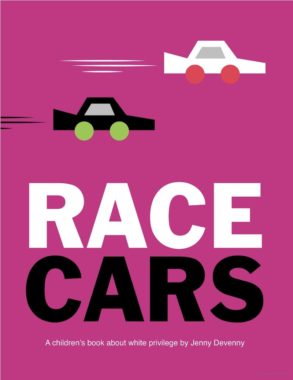Author: Jenny Devenny
Grade Level: 3-5
Standards*
- Common Core: CCSS.ELA-Literacy.RL.3.1, 3.2, & 3.3; CCSS.ELA-Literacy.RL.4.1, 4.2, & 4.3; CCSS.ELA-Literacy.RL.5.1, 5.2, & 5.3
- Virginia Standards of Learning: 3.5; 4.5; 5.5
Overarching Theme(s): White privilege, Fairness, Point of View, Empathy, Inferencing
Timeframe: (45-60 minutes)
Summary
This is a book about white privilege. It uses race cars to facilitate conversations about race, oppression, and how white privilege works. Race Cars tells the story of two best friends, a white car and a black car, that have different experiences and face different rules while entering the same race. Why is this book important? As early as 6 months, a baby’s brain can notice race-based differences; by ages 2 to 4, children can internalize racial bias and start assigning meaning to race. 5 to 8-year-olds begin to place value judgments on similarities and differences. By age 12, children have a complete set of stereotypes about every racial, ethnic, and religious group in society. Adult guidance is especially crucial during this impressionable time, and Race Cars offers a simplistic, yet powerful way to introduce these complicated themes with fidelity (Before reading, teacher should review the last two pages of the book –“Talking about…” and “Discussion Questions…”).
Lesson Goals
32. Understand implications of one group being treated better than another group
33. Brainstorm possible solutions
